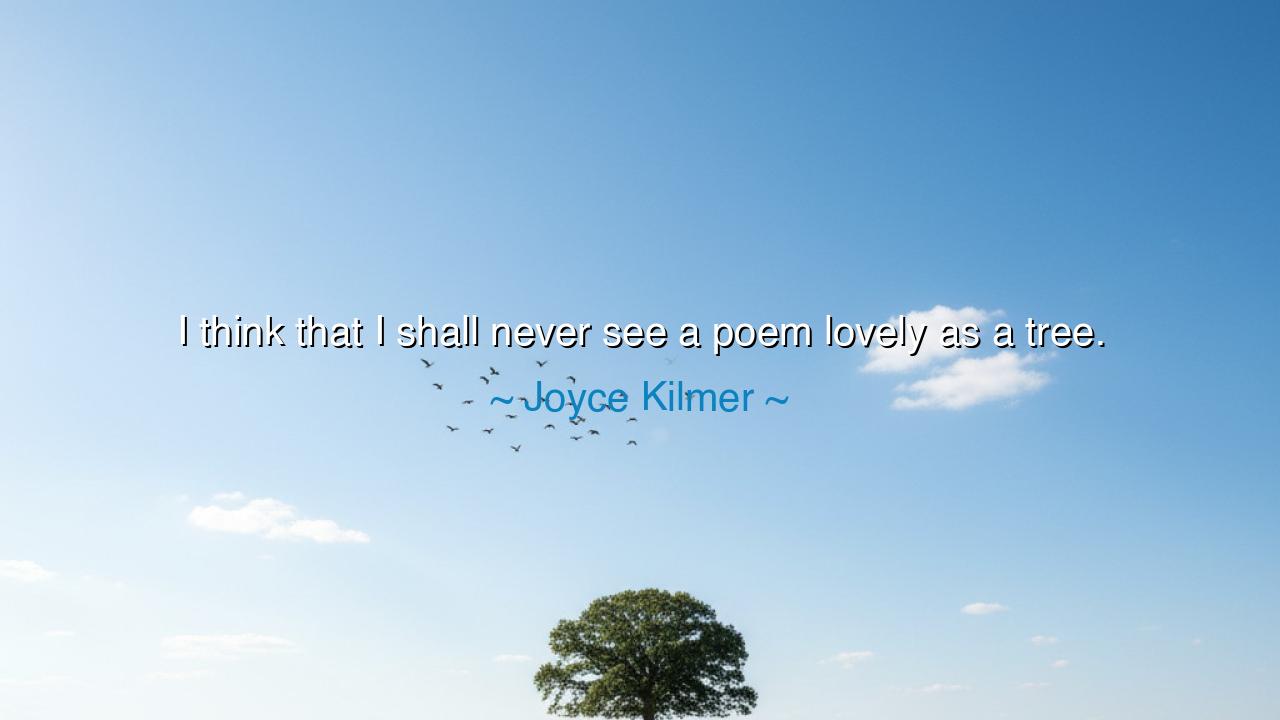
I think that I shall never see a poem lovely as a tree.






Joyce Kilmer once wrote the immortal line: “I think that I shall never see a poem lovely as a tree.” In these few words lies a truth that humbles both poet and reader alike. For Kilmer, though skilled in weaving words into verse, confessed that no human creation—no stanza, no sonnet, no hymn—could rival the living splendor of a tree, fashioned not by man but by the hand of the eternal. The tree, with its roots drinking deeply of the earth and its branches reaching toward heaven, is itself a living poem, written not in ink but in leaf and light.
The origin of this reflection lies in Kilmer’s poem Trees, published in 1913, at a time when industrialization was spreading and cities began to rise against the horizon. In that age of steel and smoke, Kilmer sought to remind the human heart of the divine artistry still surrounding them. While poets may labor to craft beauty with words, Nature herself had already written works far more profound, more intricate, and more enduring. The tree, silently growing, offering shade, bearing fruit, sheltering life, was for him the highest verse of all.
The ancients, too, revered the tree as a sacred symbol. In Norse myth stood Yggdrasil, the World Tree, binding together heaven, earth, and underworld. In India, the Bodhi tree became the seat of enlightenment for the Buddha, under whose branches wisdom blossomed. Even in the Scriptures of the West, the Tree of Life is the emblem of immortality and divine presence. Thus, Kilmer’s words are not only personal but universal: the tree has always been seen as a bridge between the mortal and the eternal, a natural poem whose meaning cannot be exhausted.
History offers us stories that illustrate this truth. Consider the life of Johnny Appleseed, the American frontiersman who wandered across lands planting apple trees. His legacy was not written in books but in orchards—living lines of poetry that fed countless families long after his passing. Or think of Wangari Maathai, who in modern times led the Green Belt Movement in Kenya, planting millions of trees. Her struggle against deforestation was itself a verse of justice and renewal. In both stories, the tree stands not merely as a plant but as a line in the greatest poem: the poem of life itself.
The meaning of Kilmer’s words is also humbling for the artist. He admits that the highest artistry is not in human hands but in the Creator’s design. To call a tree a poem is to recognize that true beauty, true inspiration, is not invented but received. Man’s role is not to surpass nature, but to notice it, to honor it, and to live in harmony with it. Kilmer’s line is therefore not despair at poetry’s weakness, but wonder at nature’s strength.
The lesson for us is clear: learn to see the poems that are already written around you. Do not imagine that beauty exists only in galleries or books. Look at the trees, the rivers, the skies, the lives growing silently around you. There is loveliness beyond what words can hold, if only the eyes and heart are open. The poet is not one who invents beauty, but one who points to it and says: “Look, here it is.”
In practice, this means cultivating reverence for nature. Plant trees, protect forests, spend time beneath their branches. Let them remind you of patience, of endurance, of quiet strength. Just as a tree grows slowly and steadily, so should your life seek depth, not haste. And when you write, create, or labor in your craft, remember Kilmer’s humility: no work of man can surpass the living works of creation, yet our task is to honor them, to reflect them, and to learn from them.
Therefore, remember Kilmer’s words: “I think that I shall never see a poem lovely as a tree.” Let them call you to wonder, to gratitude, to humility. For the world is already full of poetry, written in forests, fields, and skies. If you open your eyes, you may find that the loveliest verses are those that stand quietly rooted, waiting for you to notice them.






AAdministratorAdministrator
Welcome, honored guests. Please leave a comment, we will respond soon